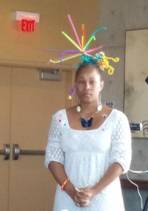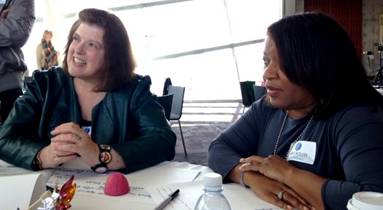Presented by Constance White, Arts Program of SD International Airport
at the New Central Library
 |
| Constance White |
 |
| Patricia Frischer and Felicia ShawPhoto by Marti Kransberg |
We were kindly welcomed by both Mel Katz, chair of the Library Commissioners and hugely responsible for the fabulous library where this symposium was held and Robert Gleason, Chair of the SD County Regional Airport Authority who funded the symposium Both agreed that the arts contributes to the quality of life in the city. The arts can make you feel safe and softening the hard edges of a cityscape.
Todd Gloria x-interim mayor and now city council president gave the key note speech. He started strongly with a statement about collaborations and how we need arts and culture to make a statement that differentiates our city from others. We are in competition worldwide and we are competing to WIN. This is about place making and the city as a brand. Balboa Park is unique and that is an anchor. North Park is the contemporary anchor as an ecodistrict.
We need our Innovation labs to generate ideas. Even the idea of the labs needs testing. Once ideas are pioneered they need to be replicated. SD will have a $38 million surplus, at least 1% of that should go from the Tax on Tourist for the arts under the agreement made last year in the Five Year Blueprint for the Arts. The difference between finest city in the America and greatest city is art. We need cutting edge projects from young and older organizations.
Community in put from creative people is essential. Gloria sees his job is to make neighborhoods better. That includes the point of entry to the USA from Mexico which should be a welcome mat and not a vewi of dumpsters.
County wide collaboration spearheaded by supervisor Dave Roberts. When young people start to want families they move to better neighborhood and then it is hard for the old neighborhood to improve. So the question is how do you give those budding families what they need to enrich the existing neighborhoods?
With the population growth expected (and this is just from new birth rates and not people moving to SD) we have to build up instead of out. Not all city council people are onboard with that yet, but they all know they are in competition and have to do something. We will have street cars again even if it takes years to happen.
Balboa Park Celebration is now under his supervision at least for the city funds. Mistakes were made for example no one ever asked what potential funders might have wanted for this celebration. It appears that they want us to looking forward, not backward. And the ideas should be those that are scaleable if they are funded. The Institutions of the park will have their own ideas and some money might be forthcoming to help them, but the question is how to have this celebration In the public spaces. Decisions will happen about this very soon. One question is how to frame to see the park in a new way?
He addressed education needs saying we must re-introduce the arts and harness the young who already have a strong service ethic. But they need to go beyond serving meals to homeless and try to solve the problem. The arts must spearhead specific action item solutions or ideas and must learn to speak the language of government and not confuse the public and politicians with art speak.
We moved on to a series of presentation and panels.
Who am I, where am I?
Tom Borrow author of the Creative communities handbook
We describe our identity by claiming it, creating it or manufacturing it. It takes 12 years to establish an identity. Who, when, and where all have to be defined. Neighborhoods are shared space, Community is shared ideas.
Seyed Alavi stated that multileveled complex ideas have better chance of being relative now and in the future. Find the fundamentals that lie within and let the surface be contemporary. Audience needs to be encouraged to be curious. When they slow down they notice details of something that has been done on purpose. Aesthetics just means Perception. Instead of necessity being the mother of invention, it is aesthetic curiosity. The word aesthetics is just a placeholder. We need to bring together risk adverse and risk takers.
Question raised in this session included. When did art become separate from the public and need a bridge? Site specific resulted from that disconnect. Who should make decisions...policy makers or artists? Can they work together? When is an idea a program and when is it a project? If you are the artist asked to make an art work about a community in which they do not live, can it be authentic?
Airport artists – combined thoughts from Stuart Keeler, Jim Campbell, Norie Sato Po Shu Wang, Erik Carlson and the Merge Conceptual Design team.
Challenge drives the creative process. Controversy brings clarity. Art is made for the public and becomes part of the public domain. Let the public become involved in the work and then that becomes the art. Goals are fuzzy so hard to judge success. Public art can teach artists something that they may have not have gained otherwise. This is not art by committee. Instead, it is an opportunity to think out loud and with an audience of possible contributors. If a work is good it might end up defining the place, even if not site specific in the beginning.
Margie Johnson Reese - Cultural Economy
Ms. Reese runs a arts program for students with hundred of collaboration to make sure art in available before, during and after school. She recommends you acknowledge abundance, cut red tape, build on what you have, find constraints, address barriers and deal breakers, and release failure. Relevant plus exciting equals engaged. Access plus quality equals equity. Middle school at 12 years become sponges, but they unfocused and can be a real challenge. Parents were one asset present in all categories. One of her most important messages was to listen to the stories of others and honor them.
Cultural Provocateurs
Werc is the first new muralist at the airport and he used the letters SAN-just like the tagging used in graffiti art. These are temporary digital works.
Michelle Hyun - USCD curatorial fellowship used the gallery as anything but a place to show and/preserve art works. The space became a 24 hour study area, lab, performance stage, etc.
Stuart Keeler - Public art can take three forms: plop art that is preconceived and is just resident in the space, art which is fully integrated in the site and art which serves the public interest, Keeler described his life as a self appointed artist in residence. He promoted his book: Service Media. The message here was don’t wait to be asked, involve yourself.
Dan Springs continues to work with other libraries now that the New Downtown Library art is installed and to administer public art when funding is available.
Bennett Feji , principal of Peji Deign firm was an enthusiastic leader of the final exercise when tables worked to present new ideas for collaboration. It was another opportunity to network with the participants. Just as Ms. Reese urged us to do, we were given some time to listen to the stories of others and honor them
A conflict in scheduling prevented me from hearing presentation from Ed Abeyta,Judit Hersko, and Oscar Romo lead by Xavier Leonard from the Civic Innovation Lab
You can read about the Global Culture Districts Networkin a report on Re-imagining Cities by John Eger. In it he announces a meeting June 17-19 in Dallas, Texas, The New Cities Foundation expects to attract over a thousand leaders from cities around the world, most of whom will hear about creative place making, technology innovations, new transportation schemes, sustainability, financing and audience building.
There is now a gallery at the Library and we enjoyed seeing the works of Gail Roberts, Ernest Silva and Philpp Scholz Rittermann.


No comments:
Post a Comment
Thank you for writing. We read every comment and review it.
Unfortunately, if your comment is anonymous it will not be made public.